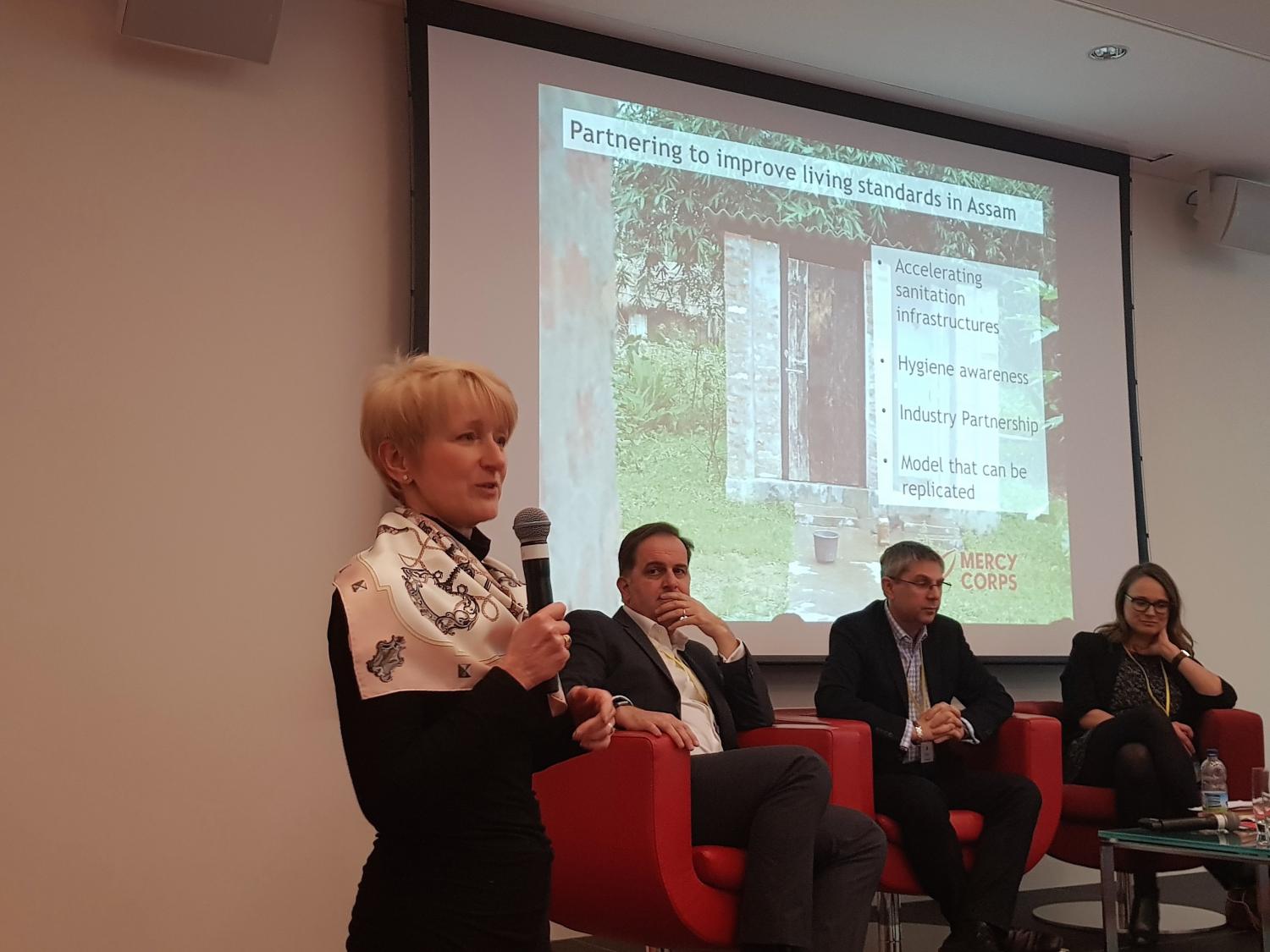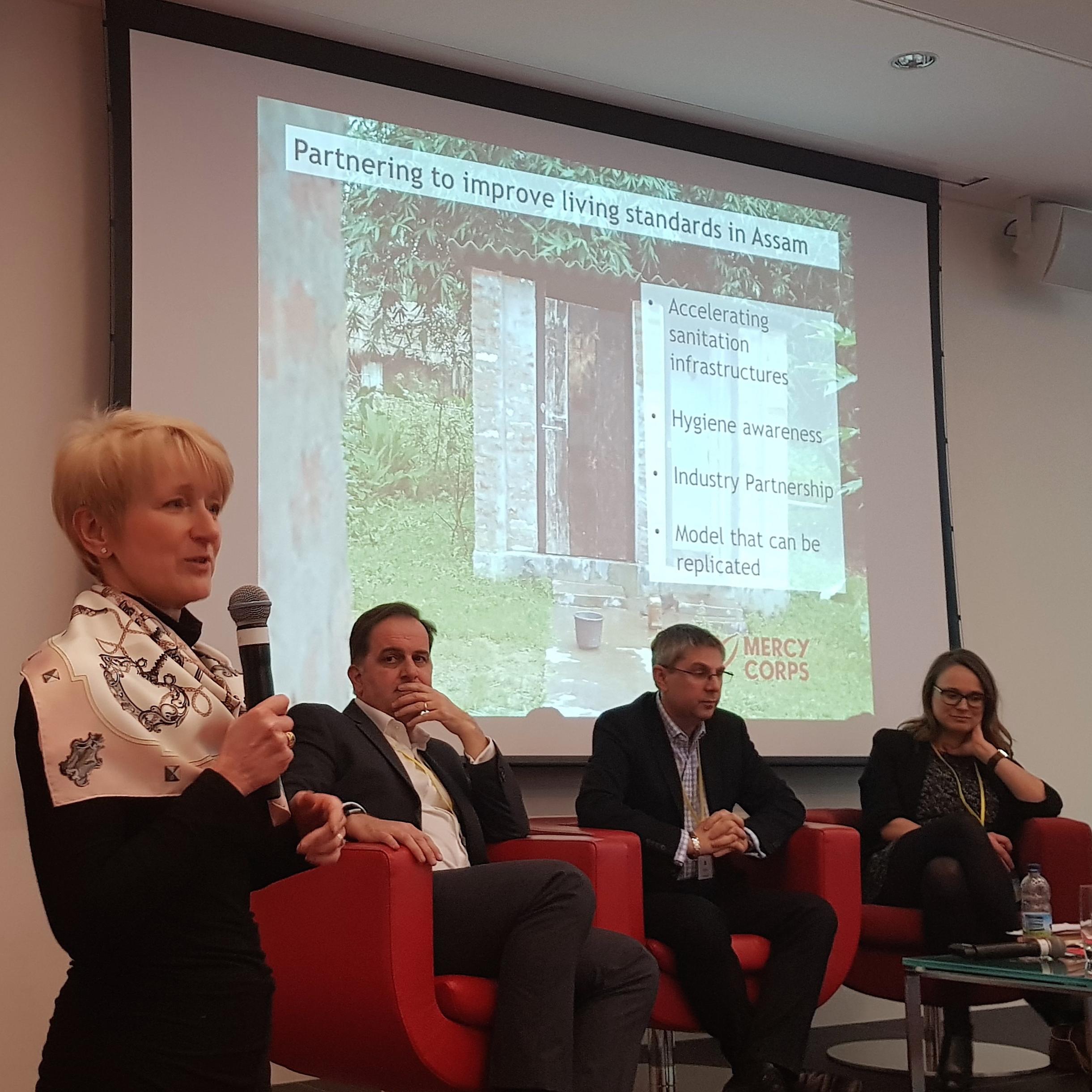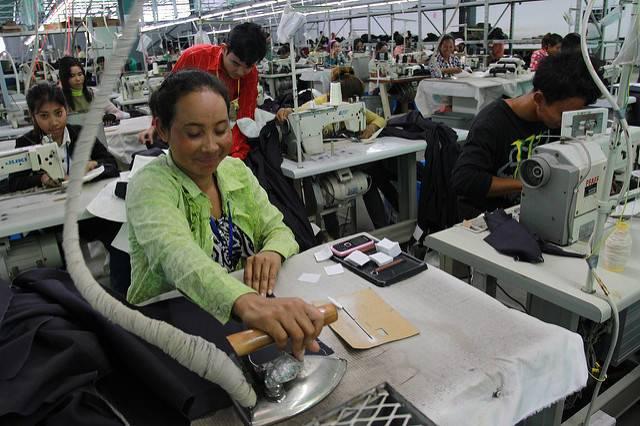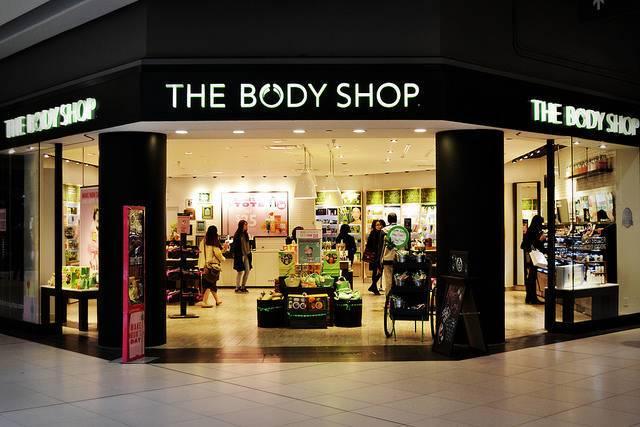Beyond modern slavery statement to strategy: what do leading businesses have in common?


On 14th November Carbon Smart attended Front Group’s 2nd Modern Slavery & Supply Chain Summit hosted at Norton Rose Fulbright. Leading businesses took the centre stage and shared their experience and opinions, sparking fascinating debates and knowledge exchanges on the day. Here are some of the highlights and the key take home messages from the summit.
Audits are dead - now is the time for real action
Although audits are a widely used tool to tackle modern slavery, it is quite clear that they are not enough on their own. This is because it is not about making sure that a supplier is compliant on a given day, but rather making sure that they are compliant all year round and this requires more than an audit.
Throughout the day, we heard how businesses are taking this important matter into their own hands by adopting a more investigative approach. For example, businesses discussed how they were carrying out series of on-going supplier site visits throughout the year, both announced and unannounced. Some businesses shared how they were rolling out awareness programmes whereby they trained the staff, who is most likely to encounter cases of modern slavery, to identify such risks. Others described how they were engaging with suppliers’ staff to understand their wider working and living conditions to gain a better picture of what is happening in their supply chain.
Be transparent
Taking the first steps to disclosing what you are doing in this space is not easy. As businesses shared their stories, it became apparent that even those who are leaders in this field, they too, found the first steps of public disclosure daunting. However, everyone agrees on the importance of transparency: not one business regretted the decision to report on their approach to tackling modern slavery publicly. In fact, businesses found that they only received praise for their efforts to share what they were doing in this space, and indeed, it even helped some to break barriers and work more closely with other businesses and agencies to make a more meaningful impact.
If you walk away, you only help yourself
Businesses with clear plans to support victims, such as working with charities in this field, or working with suppliers to tackle cases of modern slavery, were celebrated on the day. We know that a third of modern slavery victims are re-trafficked and are extremely vulnerable. By providing support and economic security through employment we can give victims of slavery a chance to break the cycle. As such, it is key that we work with suppliers to find solutions to tackling the wider issue of modern slavery, because if a business simply walks away from a problem or a supplier, they are only helping themselves.
It was an inspiring day to learn about the different journeys that businesses take to address the risks of modern slavery whilst sharing insights with other businesses as to how they can also move beyond modern slavery statements to developing a clear and meaningful strategy. However, although the UK is a leader in this area with the introduction of the Modern Slavery Act, we still have a long way to go.
50% of eligible businesses have still not complied with the Modern Slavery Act and have not published their statement as required by the UK Home Office. Furthermore, of those 50% who have published a statement, there are many whose statements don’t meet the best practice guidelines set out the by the Home Office, highlighting a commitment versus investment gap. If this gap persists, we should expect a tightening of the regulation, as the business community becomes firmer on what is the minimum we expect from ourselves and our peers when tackling modern slavery.
Collaborating to Sustain Climate Action


By Scott Tew, Executive Director, Center for Energy Efficiency and Sustainability at Ingersoll Rand
September 2017 was the fourth warmest September on record and both 2015 and 2016 saw atmospheric carbon dioxide levels increase 50 percent more than the average annual increase, according to NASA. Considering these documented examples of a changing climate, it’s no secret that work still needs to be done to support a low-carbon, sustainable economy.
While each of us must do our part, collaboration is essential to taking effective action on climate change – such as keeping the global temperature increase below two degrees Celsius, a limit outlined by the Fifth Assessment Report of the Intergovernmental Panel on Climate Change. With this in mind, here are three key considerations for business leaders seeking to partner on efforts to reduce carbon and environmental impacts, and advance long-term sustainable solutions.
Define and Align Priorities with Partners
Developing the right connections can help businesses drive toward climate goals. This may seem obvious, but how exactly can business leaders identify the right partner? The most meaningful partnerships arise from collaboration focused on similar end-goals. Therefore, business leaders should remember not to stray from their company’s culture and mission by aligning with an organization that’s out of their comfort zone.
Moreover, it is important to find partners that not only match your organization’s values, but also do not require you to compromise on your strategic priorities. For example, the NRDC was a natural partner for my organization, Ingersoll Rand, because they focus on both policy and the technical aspects of reducing emissions. Our collaboration with this group enables two-way learning, helping us both reach our climate objectives.
A good starting point for identifying strong partners is to find a non-government organization (NGO) that shares similar sustainability goals with your business. The U.N. Sustainable Development Goals (SDGs), for example, were established to inspire actors across all sectors to work toward the same targets, together. Using SDGs to identify a partner with similar climate goals can help business leaders streamline potential partners and create meaningful collaboration that helps speed innovation, and distinguish true climate action leaders.
Maximize Your Membership
Once business leaders have chosen the right partners, they should focus on making the most of these new relationships. Not only can climate and carbon-focused membership organizations help raise the visibility of your commitments to a new audience, but they can also connect your business with other like-minded, often progressive companies that you can learn from. Exposure to new ideas and perspectives will help better educate all parties involved, which in turn drives innovation and creativity around new climate initiatives.
In addition to working with NGO partners, businesses should work with academics, scientists and other thought leaders to learn and test new strategies for reaching climate goals. This can even later be used as the basis for educating key opinion leaders and policy makers. Partnering with a variety of players allows for an array of opportunities that help scale climate action across different industries and parts of business.
Don’t Forget Your Own Value Chain
Apart from working with external partners, collaboration with your own suppliers is also a necessary step to improve efficiencies in your business’ value chain. By aligning sustainability goals with suppliers, business leaders enable new carbon efficiencies within their organizations, externally for their customers, and beyond.
At Ingersoll Rand, we used to speak with our suppliers when a contract was about to end; but today, we’re interacting in different ways – working with strategic suppliers more often, discussing on an ongoing basis how we can improve our environmental impacts. After all, advancing carbon efficiencies in product lines lowers both your environmental impact and that of your suppliers, and customers.
Across all sectors, businesses are making bold climate commitments and collectively leading the way towards innovative technology development, widespread renewable energy adoption, meaningful corporate sustainability strategies, and strong employee engagement. However, businesses stand a better chance of effectively meeting environmental sustainability goals by working closely with external partners – and each other. Seeing the momentum of aggregate actions to curb the impacts of climate change is exciting and inspiring. And, the companies that collaborate to develop business strategies around global climate goals will emerge as leaders and will be among the first to succeed in achieving their set climate goals.
Scott Tew is the founder and leader of the Center for Energy Efficiency & Sustainability at Ingersoll Rand (CEES), which supports all of the company’s strategic brands – Club Car, Ingersoll Rand, Trane and Thermo King – and is responsible for forward-looking sustainability initiatives. Since the CEES was formed in 2010, Ingersoll Rand has successfully met or exceeded its long-term goals in energy use and waste reduction, while embedding sustainability in all parts of the product development process. Tew’s efforts have led to the development of world-class initiatives, including the creation of a green product portfolio, personalized employee engagement programs, and unique research on unmet needs in the green space. Tew manages all sustainability-related public transparency, advocacy, reporting and goal setting initiatives for the company.
Tourism vs. Sustainable Development: Can Resorts Be a Driver of Inclusive Growth?


The United Nations World Tourism Organization (WTO) insists that tourism and sustainable development do not have to be mutually exclusive. For the sake of the planet, that had better be true – especially since estimates suggest 1.8 billion people could be taking international trips by 2030, a 50 percent increase from last year.
Here in Jamaica, where the UNWTO has wrapped up its Conference on Jobs and Inclusive Growth, a quick scan of the all-inclusive resorts that line the highway along the country’s north shore do not appear to be a hotbed of responsible and inclusive growth. The massive gates that greet shuttles arriving at these resorts hardly scream “inclusive.” Once visitors arrive inside, the amounts of food and trash these resorts generate raise questions about whether tourism can truly become the sustainable industry its leaders say it could be.
In fact, George Washington University’s International Institute of Tourism Studies (IITS) will soon release a report showing where the Caribbean region needs a heavy lift over the next few years. The IITS’s assessment will show that some of the largest risks countries here face include climate change adaptation, monitoring tourism’s collective footprint – not to mention the struggle of gaining the buy-in of local residents who are watching tourism impinge on their way of life.
And going back to those all-inclusive resorts, the ITTS has concluded that improving local recycling and waste management systems should be the Caribbean’s top priority through the end of this decade. Developing sustainability standards in the first place, along with ensuring that tourism has minimal impact on local demand and supply linkages, also should be on the tourism industry’s radar.
Hence the fundamental question arises yet again: For an industry that caters to people who often do not want to behave the same way abroad as they do at home, can the tourism sector really drive responsible and inclusive growth?
Fundación Grupo Puntacana, the philanthropic arm of the eponymous company that was the driver of one of the most sought-after destinations in the Caribbean, claims it serves as a model of how the public and private sectors can allow tourism to thrive while mitigating any environmental and social impacts in local communities. The catch is that all stakeholders, including government agencies, private companies and nonprofits, must be involved in order to ensure this booming industry can become a force for good.
In 1969, around the time Group Puntacana identified this remote fishing village as an area ripe for tourist potential, the entire Dominican Republic had 1,500 hotel rooms. Today, Punta Cana has approximately 50,000 rooms and welcomes 6.4 million passengers a year. As the town developed and more Dominicans moved to the eastern side of the country to seek work, strains on local resources emerged. According to the foundation’s Jake Kheel, the public sector’s lack of engagement was one problem as there was little planning and oversight. Waste management systems, for example, were unreliable and local communities often lacked safe drinking water.
“But the good news was that our biggest opportunity was the power of the private sector,” Kheel told an audience at this week’s UNWTO conference, “And the biggest lessons learned was that companies can have a positive impact.”
Kheel continued to explain that Grupo Puntacana worked with local officials to strengthen the region’s environmental, social and economic equity. Overfishing had become a huge problem, to the point at which many fisherman had a difficult time finding work. For over 10 years, the company helped retrain some of them so they could find alternative work such operating boats for tourist or even helping to build local coral gardens – the latter of which helped to rebuild the shore’s coral reefs. On land, the foundation launched programs that helped turn an area hardly known for agriculture into one now known for small-scale farms that use locally produced compost to help cultivate ingredients used in Punta Cana’s restaurants.
On the social side, Kheel said the foundation has built two schools that now educate over 1,000 students. Local clinics that the foundation co-manages provide vital health services.
And when it comes to infrastructure, Grupo Puntacana says it is developing a zero-waste program while a wastewater treatment facility built in 2009 helps conserve that precious resource.
Kheel noted that what he often finds rewarding about Punta Cana’s sustainability programs is that other resort regions are learning from this model of private-public partnership – and for a good reason. “This has been integral for our business,” said Kheel, “and sustainability is the DNA of how we operate.”
Image credit: Joe DeSousa/Flickr
If Global Tourism is to Become Sustainable, It Must Break Free from Its Silo


Thanks to cheaper and more efficient air travel, not to mention the growth of the middle class in emerging economies, more people are traveling abroad than ever before. This boom will not stop anytime soon. As Jamaica’s Minister of Tourism, Edmund Bartlett, noted earlier this week at the United Nations World Tourism Organization (UNWTO) Conference on Jobs and Sustainable Growth noted earlier this week, over 1.2 billion overseas trips were taken last year. That number could surge to as much as 1.8 billion trips by 2030.
Taleb Rifai, Secretary-General of the UNWTO, minced no words in giving his assessment to the 1,500 delegates assembled in Montego Bay, Jamaica yesterday. “We could end up with 1.8 billion opportunities, or 1.8 billion disasters,” he said, “so it’s all up to us. How we manage this impressive growth is in our hands.”
The challenge, however, is to manage this growth efficiently and sustainably, without wreaking havoc on local communities and the environment – while staying focused on the international community’s goal to limit climate change to 1.5°C this century. “Growth and sustainability, progress and sustainability, should go hand in hand,” said Secretary-General Rifai, “not either - or, but a win-win equation.”
Global tourism is a driver of many things: economic development, jobs and of course, its fair share of social ills and environmental degradation. Rifai noted that 10 percent of the world’s citizens have jobs with some connection to the global travel sector, which comprises 10.2 percent of the world economy.
Yet as Secretary Bartlett noted while introducing Rifai yesterday, only one percent of the world’s financial resources are available to the tourism industry – even though it is a $7.6 trillion global juggernaut. Despite the role tourism has in opening up economies and building opportunities to earn stable income, leaders in finance, business, government and the nonprofit sector overlook this sector’s importance.
Furthermore, if the travel sector can become a force for sustainable development, that responsibility lies in the hands of small and medium sized enterprises (SMEs), which according to Secretary Bartlett, is the driver behind 80 percent of this industry. These smaller firms, from building contractors to food service companies to tour operators, often know the lay of the land and are in the best position to ensure that travel can grow without being destructive. Nevertheless, the evidence suggests these firms are not able to access credit, and are outmatched by the larger worldwide travel brands and building contractors that have access to finance, government officials and business partners to get their projects completed.
Secretary-General Rifai inferred that this trend cannot continue if the travel industry can become more inclusive and responsible. A massive shift in mindset is needed, and that includes the travelers themselves. “What we have to work on,” Rifai said, “is that visitors cannot live in bubbles.”
In other words, the all-inclusive resort model, common here in Jamaica and across the Caribbean, needs a complete rethink. “We cannot continue to have modern day plantations, as in exclusive resorts,” the Secretary-General added.
Sure, such a shift in how travelers view the places they visit is required, and changing that mindset will require courage and conviction, as Secretary-General Rifai remarked in concluding his address yesterday.
But the time has also come for tourism to burst out of its silo.
Many countries, including Jamaica, have a dedicated ministry focused on travel and tourism. At a first glance, it seems impressive that this industry has a cabinet-level position in many national governments. But as several speakers and attendees at this conference have noted, many nations overlook the impact that tourism has on their economies – the heady macroeconomic numbers are not resonating with government officials.
Ministries of foreign affairs often view tourism in the context of consular services; finance ministries seek ways to diversify their economies without finding ways to promote tourism, often an important employer; other ministries such as health or environmental affairs only take a look at tourism when a disease outbreak or natural disaster sideswipes their nation. Developing a sustainable and resilient tourism infrastructure for the long term needs careful proactive planning – too often, the approach to the travel sector has been reactive.
If tourism will continue to grow – especially in the Caribbean, where travel generates as much as 40 percent of local GDP – government agencies will not only have to work closer together, but actively involve the private sector and NGOs as well. A building contractor can provide the transport infrastructure or wastewater treatment plant that a local government cannot build or support; NGOs often have a good lay of the land and understand the sensitivities of local citizens so that they are not immediately displaced by massive resorts or a new airport. As the saying goes, the left hand needs to know what the right hand is doing.
“Together with other forces of globalization, travel and tourism is making the new world smaller, more connected and more informed, and therefore, more involved, more concerned and a more caring world, and a better world indeed,” said Secretary-General Rifai as he wrapped up yesterday’s speech.
If that is indeed true, governments have to stop minimizing the role tourism has in strengthening its economies – while ensuring that too few players take up too many resources and leave local citizens behind.
Image credit: Leon Kaye
The Global Apparel Industry Hopes a New Tool Can Eliminate “Audit Fatigue”


This week, the Sustainable Apparel Coalition (SAC) released an update to the Higg Index, the global apparel industry’s standard to assess environmental and social sustainability across the sector’s entire value chain.
Registration is now open for the new Higg Facility Environmental Module (Higg FEM), a self-assessment tool that seeks to standardize sustainability measurements for apparel, footwear, and textile mills. One goal of the Higg FEM is to allow garment factories of any size worldwide to assess their overall sustainability performance and share the results seamlessly with their supply chain partners.
In addition, the SAC is touting this tool as a way to combat “audit fatigue,” long the bane of many garment companies’ suppliers, which frequently operate on thin margins. While stakeholders in the garment sector agree audits are needed on just about everything from environmental performance to child labor, compliance can often be an overwhelming task – to the point where a garment manufacturer could be tempted to cut corners, resulting in anything from human rights violations to environmental degradation.
To that end, the SAC is optimistic that the Higg FEM can help companies within every tier of a company’s supply chain perform better by minimizing their operations’ environmental impact – and even save money and strengthen relationships with their customers in the meantime. SAC says this platform is used by over 8,000 businesses worldwide, and will become even more efficient by how it monitors water consumption, waste, emissions, and the management of chemicals.
Some companies have been quick to buy into this updated auditing system.
“Six years ago, we adopted the Higg Facility Environmental Module protocol, enabling Target to take a more unified approach to measuring our environmental performance,” said Ivanka Mamic, senior director of responsible sourcing at Target in an emailed statement. “The Higg FEM provides tremendous value by creating an industry standard and identifying opportunities where suppliers can operate more efficiently, meaning companies like Target can focus on reducing impact in the communities where we operate.”
The SAC is pinning its hopes that wider adoption of the Higg FEM will help transform the apparel industry into a more accountable and sustainable one. Through a campaign it calls Link by Link, the SAC is urging its 200-plus members to implement the tool globally, with the aim to target 20,000 facilities and 400 brands online with the new version of Higg FEM by the end of next year.
Current members of the SAC include Adidas, C&A, Columbia, Eileen Fisher, Gap Inc., H&M, Levi’s, Nordstrom, Patagonia, Puma, Under Armour, Walmart and Zappos.
Image credit: World Bank/Flickr
Airbnb: Tourism Will Drive Sustainable Growth in Developing Economies


According to Airbnb, growth in international tourism is occurring at a rate twice as high as in developing economies, at 4.4 percent versus 2.2 percent. By 2030, over one billion travelers will land in emerging economies annually.
Those numbers generate high expectations that more people can be lifted out of poverty – and raise fears that these visitors could trample upon local communities’ environment and way of life, as discussed this week at the United Nations World Tourism Organization’s (UNTWO) Conference on Jobs and Sustainable Growth this week in Montego Bay, Jamaica.
Airbnb, however, insists that its platform can help more families worldwide build wealth. For almost a decade, the online room sharing service has allowed users to rent out spare rooms, apartments, villas and even a castle here and there. And with the recent addition of Airbnb’s Experiences platform, by which travelers can book activities such as cooking classes, local tours and even burlesque lessons or truffle digging, the company says more citizens in more places can benefit financially from international visitors.
The company’s diversification of its online travel offerings scored the buy-in of Jamaica’s Minister of Tourism, Edmund Bartlett, who yesterday asked an audience at the UNWTO conference, “How do you add more stakeholders to this sector and allow more people to benefit from tourism? And how do you prevent us from being the victims of our own growth?”
One answer has been Airbnb, which says 2,900 hosts across the Caribbean island nation hosted over 50,000 visitors last year.
Furthermore, Airbnb says organizers of “Experiences” keep about 80 percent of their generated revenue; hosts on average keep about 97 percent of the prices they charge their overnight guests.
Contrast those numbers with how most industries operate, added Christopher Lehane, Airbnb’s global head of policy and public affairs. “In most sectors, the company that sits on top of the supply chain gets the most money.”
Airbnb, however, has turned that traditional model upside down, giving its suppliers the flexibility they need to allow guests when they want on their terms, while pocketing most of the cash.
Lehane arrived in Jamaica to announce the company’s plan to broaden its Trips platform to Jamaica, as well as agreement the company has made with the country's government to find ways to make the country's travel sector more inclusive. In addition to accommodation bookings, this service allows users to visit local communities and join activities organized by local hosts and experts. A pilot the company recently launched in Jamaica has generated $6 million in revenues to date, explained one Jamaican tourism official to TriplePundit.
Airbnb says a focus on countries such as Jamaica will foster a more inclusive travel industry. The company expects 400 million guests to use its online booking service by 2030 while staying at the homes of over 28 million hosts. And much of that new activity will occur in emerging economies, allowing underserved communities to piggyback on the global tourism boom. The company expects the global surge in mobile technology and broadband access to help make this push possible. But despite the proliferations of cell phones and broadband, many regions of the world still lack access to more robust economic opportunities and offer little, if any, upward mobility.
To that end, the company has tested pilot programs around Cape Town, South Africa, at one of the city’s oldest black townships; that project will expand to more townships over the next few years, said Lehane. In rural India, the company has entered a partnership with a trade union comprised of 2 million Indian women – one example of how Airbnb says it is striving to ensure its services can give an economic lift to more women worldwide. Another project in Jordan involves giving Syrian refugees an opportunity to share their stories with visitors – aligned with Airbnb’s goal to find temporary housing for 100,000 refugees worldwide over the next 10 years.
Image credits: Leon Kaye
Musk Talks Up EV Trucks, But Nikola's Hydrogen Could Steal The Show


Tesla co-founder Elon Musk's flair for publicity was on full display earlier this month, when he transformed the launch of a new long haul truck into a showcase for a sporty new roadster. Meanwhile, though, he might want to keep an eye on the competition. Last year the startup Nikola Motor Company introduced plans for a hydrogen fuel cell truck, and it has been quietly taking steps to build a network of hydrogen fuel stations to make them go.
Hydrogen vs. batteries
Musk once famously dismissed hydrogen as an unworkable fuel for electric vehicles. Until recently, he would have had plenty of company. Hydrogen is an abundant element but it must be manufactured and compressed for use in fuel cells. Battery-powered electric vehicles also have a head start on improving efficiency and tamping down costs for the mass market.
However, hydrogen has been attracting significant interest from auto manufacturers, and the U.S. Department of Energy has been pouring R&D dollars into improving the technology.
Japan and the EU are other hotspots for hydrogen fuel cell development.
Hydrogen fuel cell vehicles are run on electricity, just like their battery-powered EV cousins. One main difference is that battery EVs can be charged up conveniently at home or work. On the other hand, a hydrogen fuel cell can be fully refueled in a matter of minutes, just like a conventional gas vehicle.
One sticking point for fuel cell EVs is the availability of public fueling stations. That obstacle is beginning to fall away, and it looks like hydrogen fueling stations will be dotting the landscape in the foreseeable future.
Nikola and fueling stations
Battery EVs also faced a public fuel station bottleneck when they were first marketed several years ago. Musk solved the problem by building his own network, and that strategy has been adopted by Nikola.
Right around this time last year, Nikola launched its Nikola 1 long haul, zero emission truck in partnership with Ryder, which will provide distribution and maintenance services nationwide.
At the time, only a few states -- California, Connecticut and a handful of others -- were engaged in developing hydrogen fuel station networks. So, rather than depending on public stations, Nikola took a page out of the Tesla playbook. With the launch of Nikola 1, the company also announced ambitious plans to build its own network of hydrogen fuel stations:
“Nikola is in the process of developing multiple 100-megawatt solar farms to create hydrogen from electrolysis,” the company says. “Nikola will convert solar energy to hydrogen on-site using only energy and water, making it the only fuel that is zero emission from production to consumption.”
If you caught that thing about solar power, that's a key element. Fossil natural gas is the primary source of hydrogen, but it can also be sourced from biogas or by electrolysis. Electrolysis refers to "splitting" water with an electrical charge, and that can be drawn from renewable energy sources including solar, wind and hydro.
Hydrogen fuel stations for long haul trucks
Fast-forward to this November, and it looks like those ambitious plans are moving forward. Nikola has already introduced two fuel stations and last week the company announced a supply arrangement with the company Nel ASA, which specializes in electrolysis-based hydrogen production.
The new partnership will result in a total of 16 fuel stations including the two already built. That doesn't sound like much but it's a big step up from the company's initial plans, which involved only eight stations. According to Nikola, the 16 stations will provide coverage for more than 2,000 miles.
Here's the rundown from Nikola:
Each Nikola truck is anticipated to consume around 50-75 kgs per day. Each Nikola truck will store between two and three megawatt hours (MWh) of energy. Each station will have around 4,000 kgs of backup storage for redundancy. Each station is anticipated to produce hydrogen at 700 bar (10,000 psi) and 350 bar (5,000 psi).
With the increased number of fuel stations in the works, it appears that Nikola is no longer committed to 100 percent renewable hydrogen. However, the company has stated that it will produce hydrogen "through zero emission methods whenever possible." For stations that can't access renewables on site, the local grid mix could help reduce the use of fossil fuels.
Sweetening the hydrogen pot
Nikola states that it already has thousands of interested customers signed up, and no wonder. The company claims a 15-minute fueling time for a range of 800 to 1,200 miles for the Nikola 1 long-haul, and it is free fuel, to boot.
More to the point, Nikola states that operating costs run about half as much as a diesel-powered truck.
Nikola has also introduced a short-haul "day" version, the Nikola 2, with a similar range and fueling time along with the free fuel offer.
That could just be the beginning. The U.S. Army has been dipping into the hydrogen fuel cell EV arena, and now it looks like the Marines are on board. Nikola is developing Nikola Zero, a UTV (utility terrain vehicle) that can fit into a U.S. Marine Corps helicopter.
Hydrogen fuel cell watercraft are also in the works for Nikola, so stay tuned for more on that.
Photo (cropped): via Nikola.
What The Body Shop Has Learned About Keeping Its Values After a Takeover


By the Global Good Awards
The Body Shop is back. More than 10 years after its surprise take over by French beauty giant L’Oreal, and fresh from being bought by ethical Brazilian beauty brand Natura, the pioneering beauty brand is ready to redefine ethical business for the 21st century. We caught up with International Director of Corporate Responsibility and Campaigns, Christopher Davis, on how the original ethical brand has kept its values after two takeovers.
Davis is passionate, outspoken and has obviously experienced real change throughout his 14 years at The Body Shop. Originally taken on to work with founder Anita Roddick on campaigns, he’s forthright about the challenges of staying true to the spirit of adventure that made The Body Shop unique:
“Anita had a brilliant radar. She was always looking outside the business and into the outside world, embracing movements and communities like Fair Trade and groundbreaking, interesting NGOs.”
“The biggest change I’ve observed was being part of the L’Oreal group. Anita was such a visionary leader and because of that the company itself was an adventurer and an innovator. It was hard to continue to flourish as an adventurer when we were part of a much larger group.
For example, the company found itself unable to form the kind of partnerships with the real trailblazers they had done before, in part due to Roddick’s absence (she sadly passed away in 2007, shortly after the sale to L’Oreal). An influx of more traditionally business minded people had also diluted the distinct culture that set The Body Shop apart from others in the beauty industry.
The endeavor had started out in great faith, with Roddick confident that she had ensured The Body Shop’s principles were protected under the terms of the takeover, insisting they could be a “Trojan horse” to bring about change from within:
“In the earlier years of L’Oreal, we had enough independence and could push things through we could believe in. The last campaign we worked with Anita on, on human trafficking, changed laws across 23 countries and was presented to the UN Human Rights Council. It was a big deal. But L’Oreal were surprised we were doing it. There wasn’t much evidence of the campaign in our stores, and it didn’t focus on beauty. But it was a natural thing for our staff and people to want to do. We looked at ourselves as much bigger than the beauty industry. What changed later was that the advocates for looking at the Body Shop through the lens of business for social change got quieter. That’s where the transformation started.”
Yet, after an uneasy period, The Body Shop appears to be back on track, reaffirming its desire to do ‘business as a force for good’ launching 14 targets for 2020, under its Enrich Not Exploit™ Commitment. Not only that, but September’s takeover by Natura has given them confidence that their belief in becoming “A business that the planet, not the markets need”, is possible. They’re now determining how they can reach ‘zero harm’ with consultancy Future Fit.
Davis outlines the scale of their ambition:
“I hope soon, we will be looked at once again for reinventing ethical business. Some of the things we pioneered are now mainstream, such as our Community Trade programme, encouraging our customers and employees to campaign, and of course, cruelty-free cosmetics.”
Although sustainable business has come far in the 11 years since their original takeover, Davis still thinks it needs to be reinvented:
“When oil companies are riding high in the Dow Jones Sustainability index, you realise that the definition of a sustainable business doesn’t exist! Our 2020 goals are practical and tactical, but they’re not yet the transformation the world needs. The groundbreaking leap comes when we start to drive Future Fit and we embrace a clear destination with measurable science.”
He continues:
“The job of trail blazers has to be reinvention of what it means to be an ethical or responsible company. Look at what’s still happening to politics and the planet. What many describe as ethical business in its current form has failed and is failing!”
And Davis has an enviable remit to do so. Brazilian company Natura are well known internationally for their ethical business credentials and are a founding member of the Union for Bioethical Trade. Not only that, but Davis is confident that, despite the changes over the years, The Body Shop has the people for the job:
“What’s astonishes me is still The Body Shop’s people. They still have the mindset that they want to work for a business that’s different. We still work with our first Community Trade partners, after 31 years. When we launched our sustainability strategy last year we stated we would be the most sustainable company on the planet. And we still believe that, across our 66 countries and multiple franchises.”
So, how has the pioneering business stayed true to itself and what makes this takeover a better fit than the last? Over to Davis:
Founders who ‘get’ you
“The biggest impact we have felt already [from the takeover by Natura] is from the founders and founding philosophy of Natura. The three founders are entrepreneurs at heart, with a deep belief that business should be about making things better. Simply by talking to these three gentlemen, many of us felt like there was a weight off our shoulders. They want to do what we want to do.”
Big ambitions that align
“Natura have long-term goals to be a company responding to planetary and societal needs by 2050. I can’t tell you what that means on a practical level, but on a softer level we have more clarity and more understanding of the purpose of the business: which goes beyond returning money to the stock market. And it’s had a real effect. We now think: ‘let’s be as profitable as we can be, because we share it with our shareholders, whilst also driving our environmental and social agenda.’ It’s much more motivating.”
Enshrining your mindset and culture
“True ethical business needs to scale for us to have real impact. So I won’t say: ‘don’t sell to a large business’. But you should sell to a business that shares your beliefs, and formalise those where possible. If you look around at the acquisitions of purpose-led businesses, there are a few success stories, but there are few that have been straightforward. When Ben & Jerrys sold to Unilever, they put in an independent board and that was the thing that saved them. Formal mechanisms show the acquirer takes you seriously. Under Natura, our CEO is empowered to drive the company in the way they want to, giving us independence.”
The Body Shop’s story is one of belief, struggle and reinvigoration. And Davis is positive about their future and new remit:
“I hope we’ll be doing such a good job [the mainstream] will join us. [In five years’ time], I hope to have learned a lot from Natura that is true and deep.”
This is part of a series of interviews with Global Good Award winners and finalists, which seeks to reward the businesses, NGOs and social enterprises doing ‘good’ across the world. Entries start on December 1 and run until February 2.
Achieving the SDGs in the UK will help us fight climate change


The latest round of global negotiations on tackling climate change, COP23, has come to an end.
These UN talks are hugely important, highly complex and will never end, because climate change is going to loom larger and larger as an issue of concern through this century.
But I hope one big picture which the negotiators from nearly 200 countries won't ever lose sight of is the need to closely link action on reducing emissions and coping with climate change to the UN's Sustainable Development Goals - the SDGs.
These goals provide a golden opportunity to help nations make sustained progress on addressing global warming - both individually and collaboratively.
The 17 wide-ranging goals were developed in a groundbreaking way with civil society organisations, including Bioregional, and agreed by world leaders in 2015.
The SDGs recognise how the environmental and social aspects of sustainability are interconnected. There is a standalone Goal, number 13: "Take urgent action to tackle climate change and its impacts". But they acknowledge that national policies and global programmes on climate change won't be effective if they are devised in isolation; they need to join up with action on poverty reduction and inequality, health, education and so on.
They also recognise the roles and responsibilities of all - governments, business, civil society and citizens - in creating positive and necessary changes. And they are meant to apply everywhere, in countries rich and poor.
We often hear about UK showing international leadership on climate change, but to date, this has not been the case for the SDGs. The government's unwillingness to adopt, or even discuss, how we can achieve the SDGs at a national level has been very disappointing. Ministers seem to see them only being relevant to UK overseas aid. Two years on from the SDGs being agreed by all nations, there is no UK national plan for implementing them, unlike in neighbouring countries such as Finland.
We now have an opportunity to demonstrate UK leadership on the SDGs - and by doing so, will help us make progress on tackling climate change - while bypassing our Brexit-distracted and over-burdened government. We're starting work on the world's first stakeholder-led national action plan to implement the SDGs.
Who are we, you may ask? We're a very wide-ranging network of business and civil society organisations who share a belief that the SDGs are truly important and useful for unravelling and solving the deep and challenging sustainability problems we face in the UK. Bioregional is proud to be involved as co-founders and co-chair of UK Stakeholders for Sustainable Development.
Our plan will have 17 chapters, each one devoted to one of the SDGs. It will show where the UK is falling short against the SDG targets, the opportunities they present, and the challenges we will need to address to achieve them. Together, the UKSSD network will present it to the UN's High Level Political Forum on the SDGs in New York at a dedicated launch event.
We want our plan to be a model for other nations to follow, and we hope that our own UK government will want to get involved.
If you would like to get involved in supporting the development of this plan - and in helping the UK to become a fairer, happier nation, while living within planetary limits, let us know here.
Agricultural Evolution: Carbon Neutral, Climate Smart


A new climate for agriculture
In the first part of this series on Climate Smart Agriculture, TriplePundit spoke with Dr. Jeff Seale, Agricultural Environmental Strategy Lead & Associate Science Fellow at Monsanto. We looked squarely at the challenges facing farmers in the coming decades, among them:
- A rapidly changing climate;
- Billions more people to feed on about the same amount of land used today to grow food;
- Developmental inequity in an often lopsided global economy.
It’s a difficult situation, but, as we alluded to in our initial discussion, no solution is possible without a challenge. They are two sides of the same coin. The greater the challenge, the more thorough the solutions.
We’ll turn our attention now to those solutions and Monsanto's carbon neutral commitment.
Save our soil
“The soil is the great connector of lives, the source and destination of all. It is the healer and restorer and resurrector, by which disease passes into health, age into youth, death into life. Without proper care for it we can have no community, because without proper care for it we can have no life.”- Wendell Berry
Our success as a species boils down to the ground beneath our feet. Without just a few inches of healthy, nutrient-rich topsoil, global agricultural would fail. People would starve. Successful agriculture depends on healthy soil. It's a hard lesson when we forget.
Tilling and the Grapes of Wrath
Tilling the soil is a technique that stretches back to the emergence of agriculture. Farmers in ancient Egypt used sticks to loosen and turn the soil by poking holes to plant seeds. From sticks to draft animals pulling rudimentary plows to enormous fossil-fuel-powered machines. Eventually, intensive tilling took its toll on the land and the people that farmed it.
The Great Dust Bowl in the 1930s exposed the cost of extensive soil tilling. This, combined with severe drought, in the American Great Plains, compromised farmers’ ability to productively grow crops and families were forced to find more fertile lands to farm.
Techniques for low and no-till planting slowly took hold in the 1950s. The 2012 Census of Agriculture reports more than one-third of U.S. cropland, some 96 million acres, is no-tilled.
But, as Dr. Seale explains, there's more to modern no-till farming than just erosion control.
No-till climate mitigation
The soil is a key element of the planet's natural carbon cycle. The more we disrupt the soil, the more we interrupt that cycle. No and low-till "helps keep carbon in soil," says Seale. Where it belongs. "The technology that we developed over the last 20 years that's already been widely adopted for weed control allows for no-till," he says.
"If you look at those technologies... over 20 years we removed roughly 227 million metric tons of carbon from the atmosphere from the aggregate." That’s the equivalent of taking 43 million cars off the road for a year.
Moving forward, the Soil Health Partnership (SHP) continues to "identify, test and measure farm management practices that improve soil health." The SHP is supported by Monsanto and a bevy of other leading companies and NGOs: Natural Resources Conservation Service, The Walton Family Foundation, Midwest Row Crop Collaborative and The General Mills Foundation, with technical support from the Environmental Defense Fund and The Nature Conservancy.
Getting our fix
The Haber-Bosch Process was a revolutionary idea: fixing nitrogen from thin air. Take nitrogen, add heat, high pressure and hydrogen, and you've got fertilizer. You've also jump-started nature's nitrogen cycle. The nitrogen inputs help plant growth but also release N2O, nitrogen oxide, back into the atmosphere, a greenhouse gas 298 times more potent than CO2. If plants could fix their own nitrogen, "it would be a breakthrough miracle," Searle says. If the sky rained gold, we'd all be rich (or gold would be worthless). The point is that, while we can intercede in natural cycles, the laws of plant biology are immutable. With the Haber process came a sharp increase in nitrogen inputs into soils. It helps feed the world but also contributes to climate change, water pollution and expanding "dead zones" in many coastal areas around the world. Sometimes, the best new ideas are really old ideas fallen into disuse.
Cover crops, for instance.
Cover me
Before the widespread use of chemical fertilizers and pesticides, cover crops - green manure - replenished the soil, reduced erosion and helped defend against pests. Cover crops also improve water quality and help reduce nitrogen runoff.
Monsanto and its climate-smart collaborators understand that innovation often entails simply letting nature run its course. Reduced tillage, cover crops, keeping the "stubble in the field, all relatively simple and available to most all farmers, are the foundation for healthy soil. It goes even deeper than that.
The root of the matter
Unseen microbes within soil and plant roots play a significant role in soil, plant, and ecosystem health. Unlike tilling and cover crops, however, microbial inoculants have only recently been added to the agricultural toolkit.
“Until recently, the microbiome had been easy to ignore in plant science because soil was considered a 'black box' for so long," says biologist Marnie Rout in a 2013 ScienceDaily article,"But microbial research approaches and molecular techniques are illuminating this unknown -- essentially, shining light on the microbiome."
Monsanto collaborates with research organizations and test farms to better understand the microbial benefits of climate smart agriculture. Harnessing these naturally occurring microbial processes reduces chemical inputs and greenhouse gas emissions, enhances crop yields and decreases fossil fuel use. Recent U.S. field trials show an average increase in yield of 4 bushels-per-acre. For farmers and scientists alike, this new light on the microbiome portends "the next big thing" in agriculture.
We've examined solutions beneath our feet. Now we look up. From microbes to satellites.
Big Data down on the farm
You and I employ GPS technology to find the nearest Starbucks or the way home. Farmers use it for precision. A typical plot of farmland is "very heterogeneous in every property" Seale explains. "The soil can vary across just a few meters of the farm."
We're able to take in that data at that level and we can write a prescription." The prescription uploads to an iPad in a farmer's tractor. The data goes to a precision planter capable of processing multiple seed hybrids, telling it which seed variation and spacing is best for each few meters soil. Another tool for maximizing yield and minimizing impact.
But there's more than one way to skin a cat, as a teacher of mine used to say. How are new methods and technology assessed? How can a farmer tell which combination of technology and methodology is best for each particular circumstance?
Model, test, iterate
The power of supercomputing is, at least in part, iteration. Monsanto worked with a data processing firm to calculate 640 combinations of inputs, outputs, soil health and seed variety across the 12 states of the corn belt. Each of these scenarios runs against a greenhouse gas model, producing 200 million computer simulations. Even supercomputers can't see into the future, but it's the closest we get to predicting it. By modeling millions of iterations, we are able to make smarter predictions and optimize resources.
Revolution or evolution: no going back
“It is an urgent situation. We can't wait for everything to be perfect. We've got to go with what we’ve got."- Dr. Jeff Seale
I remember traveling as a child with my family through Nebraska, Oklahoma, Iowa - America's breadbasket. It was the 1960s. Golden fields of corn seemed to stretch on to forever. Occasionally I'd see a field lying fallow or a farmer working his crop. From my young perspective, there was something comforting about the neat rows of cropland, the dust rising up behind the plow. At least I think it was a plow. I'm no farmer. I suspect that much is clear. Chances are, neither are you. But we all depend on it.
Most look to the birth of agriculture as the cornerstone of human civilization. Some take a darker view, asserting that the agricultural revolution brought upon our species, as well as our earthly neighbors, devastation and disease. In his book Sapiens: A Brief History of Humankind, Yuval Noah Harari writes: “The Agricultural Revolution was history’s biggest fraud.
"Who was responsible? Neither kings, nor priests, nor merchants. The culprits were a handful of plant species, including wheat, rice and potatoes. These plants domesticated Homo sapiens, rather than vice versa.”
Harari’s perspective is fascinating, if a little disquieting, to those of us buying bread at the local supermarket. Even so, such a philosophical discussion is worthy of consideration. If only to highlight the journey of that loaf of bread, through history and from a seed in the ground to our table.
Tragic “mistake” or miraculous display of human ingenuity, there are mouths to feed. Returning to small clans of hunter-gatherers is fantastical. We are alive today because of agriculture. The path forward is through its evolution.
We must be climate smart moving forward. Clearly, there is no going back.